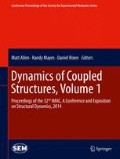Abstract
Finite element analysis of complex geometries is limited by several factors, including the time required to develop solid geometries and meshes, and the computational time required to perform the simulation of a system with, potentially, millions of degrees of freedom. As a result, the analysis of complex systems is often relegated to deterministic approaches in which geometries other than the idealized geometry rarely are considered. In order to robustly design a system, though, and to quantify the margins of uncertainty that a manufactured realization might yield, a stochastic sampling of the permissible geometries is needed. For complex geometries, a stochastic sampling can involve dozens, if not hundreds, of dimensions that can vary. Exploring a large sample space on even a modestly large model quickly becomes prohibitively expensive—and nearly impossible when a mesh change is required for each sample point. This paper presents a new methodology for utilizing reduced order models in which the number of necessary full degree of freedom models (and corresponding meshes) is minimized. The benefits of parameterizing the high fidelity model at an elemental level, the reduced order model at a system level, and the eigen-space representation are discussed. An application of the method on a model with a non-trivial number of degrees of freedom is presented.
Access this chapter
Tax calculation will be finalised at checkout
Purchases are for personal use only
Notes
- 1.
Sandia National Laboratories is a multi-program laboratory managed and operated by Sandia Corporation, a wholly owned subsidiary of Lockheed Martin Corporation, for the U.S. Department of Energy’s National Nuclear Security Administration under contract DE-AC04-94AL85000.
References
Hong S-K, Epureanu BI, Castanier MP (2012) Joining of components of complex structures for improved dynamic response. J Sound Vib 331(19):4285–4298
Hong S-K, Epureanu BI, Castanier MP (2013) Next-generation parametric reduced-order models. Mech Syst Signal Process 37(1–2):403–421
Kammer DC, Nimityongskul S (2011) Propagation of uncertainty in test-analysis correlation of substructured spacecraft. J Sound Vib 330: 1211–1224
Kammer DC, Krattiger D (2013) Propagation of uncertainty in substructured spacecraft using frequency response. AIAA J 51(2):353–361
Craig RR, Kurdila AJ (2006) Fundamentals of structural dynamics, 2nd edn. Wiley, New York
Kreyszig E (2006) Advanced engineering mathematics, 9th edn. Wiley, New York
Wolfram mathworld: finite difference (2013). http://mathworld.wolfram.com/FiniteDifference.html. Accessed 23 Oct 2013
Allemang RJ (2003) The modal assurance criterion - twenty years of use and abuse. Sound and Vibration Magazine, 14–21. http://www.sandv.com/aug03.shtml
Pastor M, Binda M, Harcarik T (2012) Modal assurance criterion. In: Procedia engineering, MMaMS, pp 543–548
Author information
Authors and Affiliations
Corresponding author
Editor information
Editors and Affiliations
Rights and permissions
Copyright information
© 2014 The Society for Experimental Mechanics, Inc.
About this paper
Cite this paper
Schultz, R. et al. (2014). Efficient Stochastic Finite Element Modeling Using Parameterized Reduced Order Models. In: Allen, M., Mayes, R., Rixen, D. (eds) Dynamics of Coupled Structures, Volume 1. Conference Proceedings of the Society for Experimental Mechanics Series. Springer, Cham. https://doi.org/10.1007/978-3-319-04501-6_17
Download citation
DOI: https://doi.org/10.1007/978-3-319-04501-6_17
Published:
Publisher Name: Springer, Cham
Print ISBN: 978-3-319-04500-9
Online ISBN: 978-3-319-04501-6
eBook Packages: EngineeringEngineering (R0)

